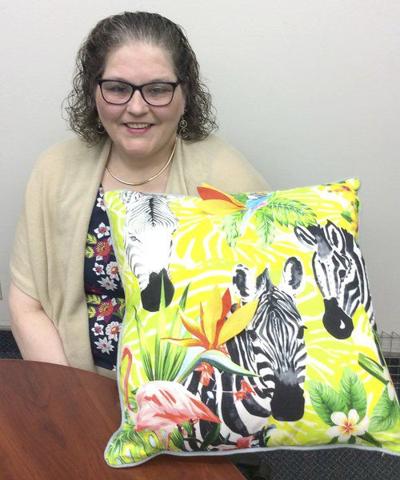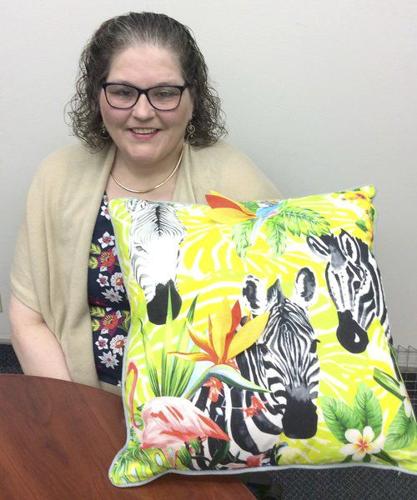PLATTSBURGH — How Lori Jamison walks and gets up and down betrays that she is one in 5,000 with Ehlers-Danlos syndromes (EDS) in the United States.
People afflicted with the connective tissue disorder are called EDSers, and through the Ehlers-Danlos Society, she knows she is not alone.
GIRL GONE
The Ellenburg Depot native’s story with the disease begins from birth.
“It’s a genetic disease,” said Jamison, who is a licensed registered nurse in New York state.
“I’ve had it my whole life. Absolutely. I was just different. We lack collagen, is the bottom line. They have not figured out how to replenish the body with collagen, which makes the connective tissue.
“If you think about what holds your body together from your skin to your internal organs, it’s connective tissue.”
Brain neurons travel along pathways.
“That’s all connective tissue,” she said.
“Your joints, your cartilage, your skin.
“We have very stretchy skin,” she said of those with Ehlers-Danlos. “We have very hyper mobile joints. If the textbook says right, we go left.
“I’ve had 19 surgeries in my life,” she added. “Part of this is allergies, and this is only my story. EDS is so complex.”
STRIPED GENOTYPES
Jamison explained EDS simply as a zeal of zebras, which is the international symbol for EDS.
“They are all the same, yet they are entirely different, and there is not two that are the same,” she said.
“This is so groundbreaking. There are new developments every day. There are new genes being discovered all the time. I describe it as EDS is a tree trunk, and there are many branches.”
Researches have isolated 13 different subsets of EDS.
“They all have different co-morbidities that go with them,” Jamison said.
“Mine is mass cell activation disorder. That means allergies of many kinds. My mother (Cynthia Rowe) will tell you if I got bit by a blackfly when I was a little girl, I would get deformed.”
She was 8 when she went to her first allergist for anaphylaxis from a bee sting.
“I was just oversensitive, hypersensitive to anything that touched me, scratched me,” Jamison said.
“You have an overabundance of histamines, which causes allergic reactions. The histamine is generated from your mass cells, which goes back to the EDS with the mass cell dysfunction.”
HERE SHE COMES
Before Jamison’s 2012 diagnosis, she was just sick, different.
“I was the accident-prone kid,” she said.
“The one who would go to camp and always have an ER trip for something, whether it was a sprain, strain, bug bite reaction ...
Or maybe she fell down an embankment — those with EDS don’t have good balance.
“We’re hyper mobile.”
For example, people usually counter a fall by jerking their body and locking their knees.
“We will hyper extend,” Jamison said. “Our knee will not lock. It will just keep on going.”
When she was a schoolgirl, she would contort her body because it would make her peers laugh.
“People would look at it and say, ‘Wow, that’s so cool!’” Jamison said.
“It gets you attention, whether good or bad as a child, but as you age it’s no longer fun or funny. So you suffer in silence.”
CAREER CHECK
Jamison’s currently in a knee brace and recovering from a broken ankle with a fusion.
EDS is under-diagnosed.
“There are many diagnoses that patients will be given over their lifetime that when this is finally diagnosed, all of them fit under this umbrella,” she said.
Over the years, she has been diagnosed with many conditions.
“All of them true and valid but ultimately caused by EDS,” she said.
“The reason why I want to share my story is I’m a licensed registered nurse who has lost my career, not lost my license. I’m sick.”
Jamison did her clinicals at what was then CVPH Medical Center, now University of Vermont Health Care Network, Champlain Valley Physicians Hospital.
She worked in mental-health nursing for Citizen Advocates in Franklin County.
Jamison was a certified medical assistant prior to becoming an RN at Clinton Community College.
Her career centered around internal medicine and office management until EDS sidelined her.
There’s no cure.
There’s no treatment.
That lack of collagen, Jamison said, “makes everything loose, everything unstable, right down to your aorta.”
GENETIC BREAKS
There are aneurysms associated with EDS, possibly a family history of them.
Jamison believes the disease stems from her maternal side of the family.
“We’re now putting the stories together because, like the zebra, we’re all different,” she said.
Her grandmother and uncle suffered abdominal aortic aneurysms.
“While there are similarities, there are different co-morbidities that make everybody different enough that it is often missed,” she said.
“So you are diagnosed with something else, whether it be degenerative joint disease, degenerative disc disease; I got it all. I’ve had back surgery.”
HEALTH CHECK
Many surgeons want to cut and fix, but their cure could cause more trauma to EDSers.
“When you have hyper elasticity of your skin, you don’t heal well,” Jamison said. “So what you’re therefore creating is more issues down the line.”
She had a perforated stomach from an ulcer, for which she’d had no symptoms.
“It just created a hole,” Jamison said.
“It’s very out-of-the-box.”
The reason she is telling her story is to educate.
“Because I think as providers we need to take a look at people who are (considered) hypochondriacs, who are med seekers, the ones that, when they come in the ER door, the medical professionals kind of look at each other like ‘OK, what now?’” Jamison said.
“You suffer in silence because you don’t know what either. Now that I know, my life is changing.”
MAKING LEMONADE
Jamison is poised to return to work, ideally in an educational or research capacity and possibly using EDS as her platform.
“I feel like I have a purpose now in medicine where I had lost that,” she said.
She’s considering starting a local chapter of the EDS Society and conducting seminars for college and medical professionals.
She doesn’t take opiates anymore but there was a time when that was the go-to prescription for her.
“You feel better,” Jamison said.
“Of course, you’re going to feel better but it creates more problems, which create addiction and right on down the line. It has been hard.”
Prevention and education are on the opposite side of the opioid crisis.
OUT OF IGNORANCE
Jamison stopped working in 2009, and it was three years later that an anesthesiologist diagnosed her.
“If you think about who does a workup for surgery, the anesthesiologist is the one that does it all,” she said.
“He kept looking at me going, ‘You’ve been through all of this?’ I’m like, yeah.” He asked her about different genetic testing, and she replied that she didn’t have that or that or that.
“Finally, he dropped his pencil and he turned around and he said, ‘My God, you’ve got Ehlers-Danlos syndromes. I looked at him and said, ‘What? What?’”
She was a medical professional and had never heard of it.
“I was bawling, just sobbing,’” Jamison said.
“I still get emotional. You cannot a fight a battle when you don’t know who your enemy is. You’re going to lose.
“I feel like I’ve won, even though I’ll never be cured.”
Email Robin Caudell:
Twitter:@RobinCaudell
LEARN MORE





























Commented
Sorry, there are no recent results for popular commented articles.